The Hawaiian islands might seem like a foreign land. After all, this is the most isolated chain of islands in the world, and the 50th state is only a few hours closer to American shores than it is to the Asian or Australian continents.
It takes six hours of flying to touchdown on the islands from LAX Airport in the nearest mainland city of Los Angeles, but you’ll only be in the air for eight hours if you fly from Tokyo. Flying in from Sydney, Australia? It’ll take just over 10 hours.
That puts the Hawaiian island smack dab in the middle of the Pacific Ocean. It’s a world away, and it feels like another world right when you step off the plane into the humid, open-air airport. The fragrance of tropical flowers hits your nostrils, the sweet sounds of the ukulele fills the thick air and tropical colors even seem a little bit brighter.
And you might be shocked to hear a few different languages being spoken around you. Hawaii is a quirky cultural mashup -- fusing native, Asian and American cultures -- so you’re bound to hear Japanese, Hawaiian Pidgin, and even the ancient Hawaiian language.
While the majority of Hawaiians speak English, some ancient Hawaiian words have survived and thrived. These words have entered the common tongue, and you’ll hear some of them repeatedly during your trip. So, if you really want to be prepared for your dream Hawaiian vacation, you’ll brush up on some ancient Hawaiian words.
You might also want to learn a bit of Pidgin, which is an English-based Creole-style language commonly spoken by locals. It derives from old plantation days when immigrant farmworkers from around the world had to communicate. But that’s for another article altogether. For now, let’s focus on a few special ancient Hawaiian words.
Aloha
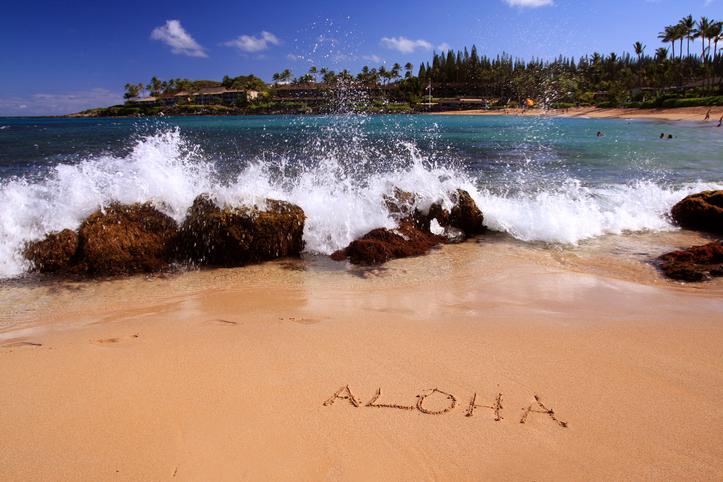 Hawaii officially became the Aloha State back in 1959. That’s when the United States Government officially incorporated the islands (which makes you wonder if it will ever happen for Puerto Rico). But Aloha is much more than a slogan. It’s a way of life that runs very deep on the islands.
Hawaii officially became the Aloha State back in 1959. That’s when the United States Government officially incorporated the islands (which makes you wonder if it will ever happen for Puerto Rico). But Aloha is much more than a slogan. It’s a way of life that runs very deep on the islands.
Have you ever dreamed of moving to the Hawaiian islands only to be concerned with “island fever?” That feeling of being cooped up on a smaller-than-normal chunk of land? Well, this island fever was a real concern for Ancient Hawaiians, as well. They had to figure out how to share such a small space with one another without tensions boiling over. It was a survival concern.
So, the ancient Hawaiian culture came up with a brilliant slogan for a peaceful, compassionate, merciful, grateful and happy way of life -- Aloha.
Yes, you’ve heard that Aloha means hello and goodbye, but the meaning is much more than a formal greeting. To the ancient Hawaiians, Aloha meant love, peace, sympathy, grace, kindness, and living with mutual respect for the land. After all, the ancient Hawaiians had to be sustainable in order to survive on the fragile ecosystems of the islands.
The old Kahunas taught Aloha to the youth by breaking down the word as an acronym. As you’ll see below, each letter in Aloha means something different:
 A - Akahi: Expressing tenderness to show kindness.
A - Akahi: Expressing tenderness to show kindness.
L - Lokahi: Expressing harmony to show unity.
O - Oluolu: Expressing agreeability to show pleasantness.
H - Haahaa: Expressing modesty to show humility.
A- Ahonui: Expressing perseverance to show patience.
So, Aloha officially means kindness, unity, pleasantness, humility, and patience. And the Kahunas of old left a roadmap for those qualities by expressing tenderness, harmony, agreeability, modesty, and perseverance.
Just think about the people of Hawaii. They always have a smile on their face (kindness), and they are always willing to listen to your stories (patience). Hawaiians are likely to invite you to a barbeque or celebration (unity) where they will treat you like royalty (humility) while lavishing your local food and tips about the island (pleasantness). It’s the Aloha way.
This is your challenge. As you make the hours-long journey to the most isolated chain of islands in the world, use the flight time to get into the Aloha mindset; to unburden yourself from the chaotic hustle-and-bustle of the mainland. So when you step off that plane into the humid air, you’re ready to show Aloha back to the locals.
Mahalo
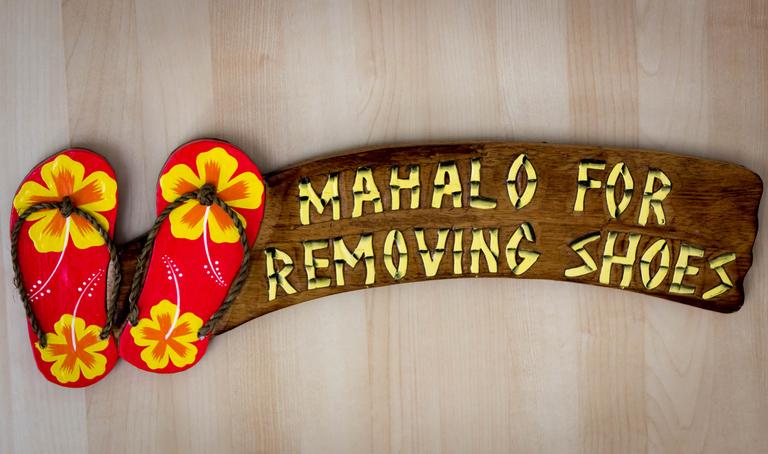 Good thing you’re reading this article because many unaware tourists hit the islands thinking that Mahalo means something derogatory. After all, you’ll see the word painted on a lot of public trash cans. So, these unaware tourists are led to believe that that locals are calling them “trash” all day long.
Good thing you’re reading this article because many unaware tourists hit the islands thinking that Mahalo means something derogatory. After all, you’ll see the word painted on a lot of public trash cans. So, these unaware tourists are led to believe that that locals are calling them “trash” all day long.
You’ll hear Mahalo a lot, but it doesn’t mean trash. The word, in its simplest form, means “Thank You.” Hawaiians live Aloha so much that they paint the word for Thank You on trash cans in order to thank you for taking care of their Ohana.
Mahalo came into the Hawaiian lexicon long after Aloha, but it is used in much the same way. Sure, you’ll hear Mahalo for something as simple as paying for an item at the grocery store, but, like Aloha, the meaning runs so much deeper.
Mahalo can be used to express deep gratitude for the world, for elders and for the universal circumstances that brought everyone together on the islands. It also means to live with compassion and a deep appreciation.
In the end, it’s a spiritual word that you’ll hear all day long. Your challenge is to not get used to it. Every time you hear the word, take a deep breath, look around you at the Hawaiian islands and feel the Mahalo; feel the appreciation you have for the circumstances that brought you to this beautiful place.
Poke
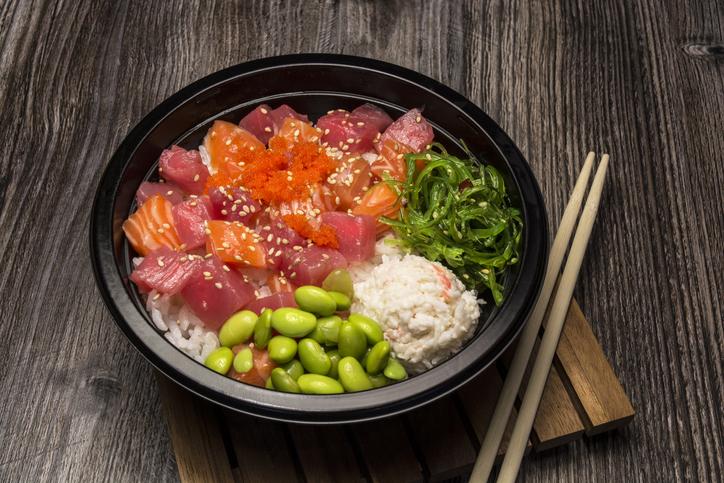 No, this isn’t like the “Poke” button on Facebook. You’re not going to go poke someone’s eye out on the islands. In fact, it’s not a verb at all. It is pronounced “Po-kee,” it’s a noun and it is absolutely delicious.
No, this isn’t like the “Poke” button on Facebook. You’re not going to go poke someone’s eye out on the islands. In fact, it’s not a verb at all. It is pronounced “Po-kee,” it’s a noun and it is absolutely delicious.
It’s no secret that Hawaii is surrounded by water. It’s nothing but open ocean for thousands of miles in every direction. And when you find yourself floating in the middle of the abundant Pacific Ocean, you make fish a staple of your diet. Just poke (no pun intended) your head underwater at one of Hawaii’s many fringing coral reefs. Fish are everywhere!
Poke is fresh fish. In fact, it’s the freshest fish. It is same-day caught fish that is cut up into raw cubes, tossed with an assortment of flavorings and served up cold. Hawaiian poke is usually ahi tuna, and it’s usually tossed with some herbs and a little bit of mayo. It’s a staple dish that is served at luaus, barbeques, and picnics. And you usually eat it with a wooden skewer instead of a fork.
But poke doesn’t have to be ahi and mayo. It can be any other fresh fish pulled up from the sea, and it can be tossed with an assortment of flavorings. You might even find cooked shrimp poke, ono poke or mahi-mahi poke. The flavorings can be simple, like lime and salt, or they can be decadent and spicy. And you can counter-service poke in grocery stores or you might find high-end poke at a five-star restaurant.
Your challenge is to try poke in a variety of forms during your vacation. If you are afraid of raw fish, start with the simplest preparation of ahi tuna poke. The mouthfeel of the fish is very meaty, like chicken, and it is much more delicious than you’d expect. Plus, tuna is the world’s best source of protein, so it’s healthy for you.
Kona
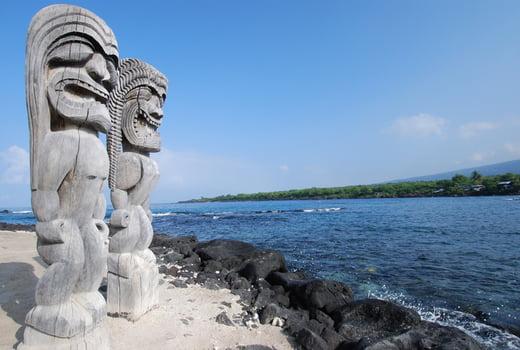 Kona is a city on the western side of the Big Island. It sits right in the middle of a field of glassy, black, dry volcanic rock. In fact, the entire western side of the Big Island looks a lot like a scorched-earth desert with the impossibly blue waters of the Pacific sparkling beyond.
Kona is a city on the western side of the Big Island. It sits right in the middle of a field of glassy, black, dry volcanic rock. In fact, the entire western side of the Big Island looks a lot like a scorched-earth desert with the impossibly blue waters of the Pacific sparkling beyond.
But Kona isn’t just a city, it’s an important Ancient Hawaiian word that means “Leeward.” Now, you might not even know what leeward means, but it is a critical sailing term that should make sailors want to moor their boats in Kona.
Leeward means the dry side of an island, and the Hawaiian islands serve as the perfect example to illustrate the importance of these sailing terms. You see, each of the Hawaiian islands grew out of the ocean on the power of a volcano, so the middle of each island is a now-dead volcanic mountain or a still-active volcano.
The raised center of each island does a lot to dictate the weather. The mountains collect clouds and deflect the wind that has been pouring across the Pacific Ocean for thousands of miles. And this weather-dictating elevation does a lot to determine the climate on each side of the island.
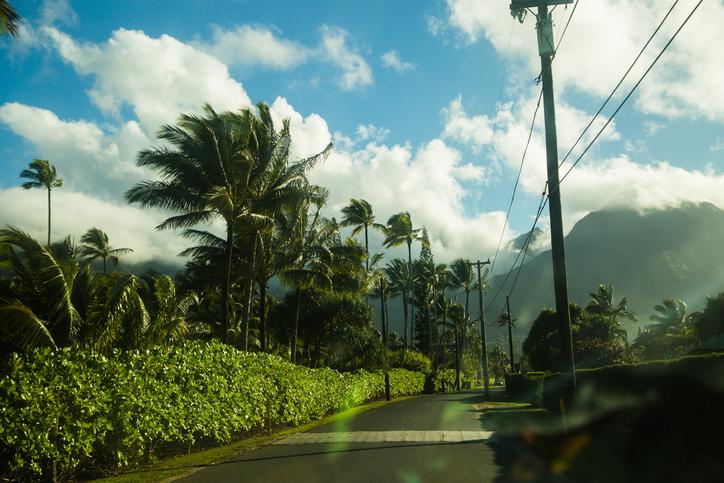 Take Kauai, for example. It’s a small island. A place where you can drive the entirety of its coastal highway in about two hours. And if you started in the north, went clockwise, and ended in the west, then you’d run into four very distinct climate zones. The north end of the island is the wettest, the east side is wet, the southern end is dry and the western side is the driest. This would make Kauai’s western side the Kona, or leeward, side of the island.
Take Kauai, for example. It’s a small island. A place where you can drive the entirety of its coastal highway in about two hours. And if you started in the north, went clockwise, and ended in the west, then you’d run into four very distinct climate zones. The north end of the island is the wettest, the east side is wet, the southern end is dry and the western side is the driest. This would make Kauai’s western side the Kona, or leeward, side of the island.
Not surprisingly, the western side of Kauai is also where you’ll find Kona coffee fields. Kona, on the western side of The Big Island, is also where you’ll find abundant coffee fields. Apparently, the Hawaiian coffee bean likes the sun exposure and dry climate of the Kona side a Hawaiian island. Hence the name “Kona coffee.”
The Kona side of the island is the least likely side of the island to see a storm, and it’s your safest bet for a Hawaiian vacation with beautiful weather. It’s also the safest place to anchor or moor a ship. So, what does the opposite of Kona mean?
Ko'olau
Kona sits on the sparkling waters of the western side of the Big Island amongst a desert-like field of volcanic rocks. Hilo, on the eastern side of the island, sits in a jungle on a river that feeds into darker ocean waters. Hilo sits on the Ko'olau side of the island; the opposite of Kona in every sense of the word. This is the wet side of the island that is more likely to see a storm, and every Hawaiian island has an area like this.
Vog
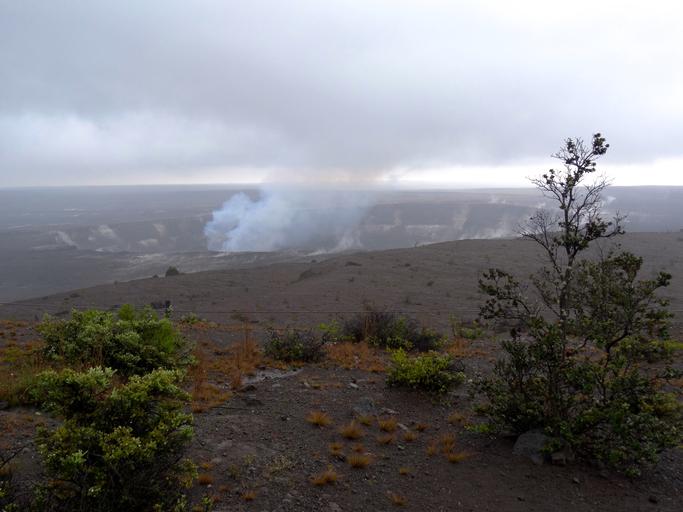 There are six still-active volcanoes on the Hawaiian islands. The most famous of which is the ever-erupting Kilauea on the Big Island. And the Big Island is home to four more of those active volcanoes including the impressively huge mountains Mauna Kea and Mauna Loa.
There are six still-active volcanoes on the Hawaiian islands. The most famous of which is the ever-erupting Kilauea on the Big Island. And the Big Island is home to four more of those active volcanoes including the impressively huge mountains Mauna Kea and Mauna Loa.
The sixth and final active volcano is Haleakala which towers over the eastern side of Maui. Its summit is where you’ll find the otherworldly Haleakala Crater National Park. But don’t worry. It’s safe to visit. Haleakala hasn’t erupted for hundreds of years.
But, if one or more of these volcanoes do happen to erupt, they will shoot molten lava and ash into the sky. Depending on the size of the eruption and the direction of the wind, the ash may be heavy enough to darken the sun on all of the islands. When this volcanic ash fog rolls in, the locals refer to it as “Vog.”
Vog can be beautiful. In fact, it adds an eerie quality to the air. Vog isn’t like normal fog. It appears to be red and gives everything a dark red hue. This makes the sun appear to be blood red through thick vog.
But vog can also be harmful to your health. It is not good for those with respiratory problems, the very young and the very old. Although rare, it’s been known to cause heart attacks. So, if you’re one of the vulnerable, you should either stay indoors or invest in a breathing mask if there happens to be vog on the island when you visit.
Vog can be so thick that it grounds airplanes. Back in 2010, a volcanic eruption on the Icelandic island grounded planes across Europe for nearly two weeks, and the Hawaiian volcanoes have the power to do the same. Unfortunately, there is no way to predict volcanic eruptions. So, if an eruption does take place during your trip, it’s best to find a spot upwind of the eruption point.
Honu
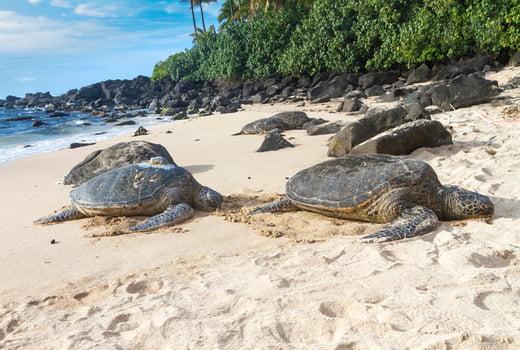 Pronounced “Hoe-new”
Pronounced “Hoe-new”
Take a stroll along one of Hawaii’s many petroglyph parks, and you’ll see one symbol pop up over and over again -- the green sea turtle. This is honu. Locals refer to those sea turtles in the water as Honu, but, like most Hawaiian words, Honu has a much deeper meaning.
The ancient Hawaiians thought that sea turtles were a sign of good luck. They believed that when a sea turtle popped into your life, that it was a guardian angel or Amakua, that has come at an opportune time.
And you’re in luck (pun intended). Hawaiian waters are absolutely teeming with Honu, so you’re likely to pick up a guardian angel during your visit to the Hawaiian islands. Your challenge is to snorkel alongside one of these gentle creatures. Just remember -- touching a sea turtle is against the law in Hawaii, and law enforcement vigorously enforces this law. Plus, the oils from your skin can degrade the turtle’s shell. Just remember to treat your new Amakua with respect, and you’ll have the powers of a guardian angel over you during your visit to the Hawaiian islands.
Hale
Pronounced “Ha-lay”
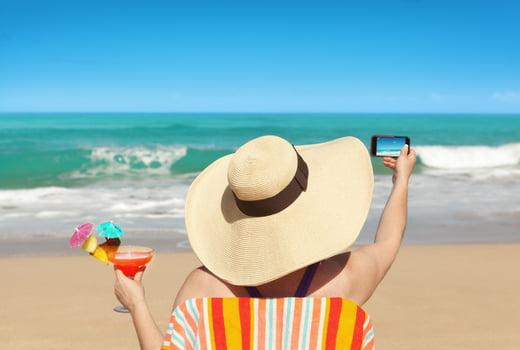 On the western “Kona” side of Kauai, there is a magical beach. It’s the longest uninterrupted beach in Hawaii, and it features sugary white sand, crystal clear waters and reliably dry weather. It’s pushed up against the southernmost cathedral cliff of the Na Pali Coast, and it is a favorite among locals for parties and overnight stays. It’s the one-of-a-kind Polihale Beach.
On the western “Kona” side of Kauai, there is a magical beach. It’s the longest uninterrupted beach in Hawaii, and it features sugary white sand, crystal clear waters and reliably dry weather. It’s pushed up against the southernmost cathedral cliff of the Na Pali Coast, and it is a favorite among locals for parties and overnight stays. It’s the one-of-a-kind Polihale Beach.
Polihale translates to the “House of the Dead,” but there’s nothing scary about Polihale Beach. It’s a spiritual place; a place where ancient Hawaiians believe your soul exits the realm of the living for the afterlife. It’s a place so beautiful that it bridges the gap between heaven and earth.
If you break the word apart -- “Poli” means the dead, and “Hale” means house. So, you might find yourself being invited by a local into their Hale or house. But, like all other Hawaiian words, it’s not quite so specific. It can also refer to a place like home, so you might catch a local referring to the entire island as their Hale. And your challenge is to treat the island as if it were your own Hale by leaving no trace.